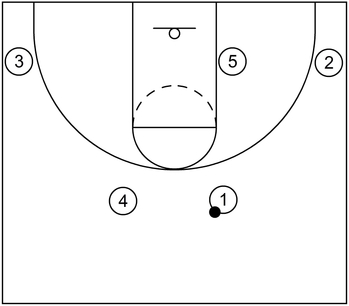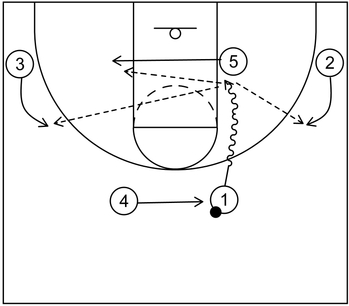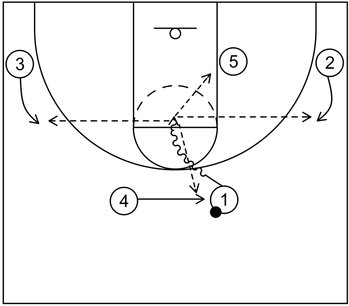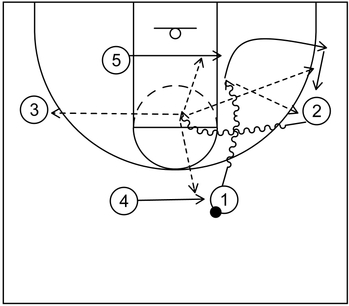What is the Attack and React motion offense
The Attack and React motion offense is a basketball offensive strategy that utilizes the fundamental principles of dribble drive, read and react, and motion offense to create scoring opportunities near the basket or near the perimeter.
Additionally, the Attack and React motion offense was developed by Andrew Grantz and it features a variety of phases that could then be used to teach the players different parts of the offense in several progressions over time.
For example, the Attack and React motion offense typically begins with the dribble attack phase but it can progress into the pass and cut phase or various other phases. This creates multiple scoring options for the offensive team while potentially limiting the strategies of the defensive team.
What is an example of the initial formation for the Attack and React motion offense

This is an example of the initial formation for the Attack and React motion offense that consists of a wide 4 out 1 in configuration. Two players should fill the slots at the top, two players should fill the corners.
These four players will typically be the offensive team’s best dribblers, slashers, cutters, or three-point shooters. Furthermore, one additional player should initially fill the low post block on the same side of the ball.
This particular player is usually the team’s best low post player and this same player also has the ability to score around the basket with ease.
On the diagram example, players 1 and 4 start at the top near the slots. Players 2 and 3 start in the corners while Player 5 starts near the low post on the same side as the ball.
Additionally, in the Attack and React motion offense, there is an imaginary line, known as the drive line, that is slightly below the free throw line extended area and it starts from one sideline to the other sideline.
Essentially, whenever a certain player cuts or dribbles below this imaginary line, it is a automatic trigger for specific players without the ball to fill a vacant area on the court.
It should also be noted that within the Attack and React motion Offense, the perimeter positions are interchangeable, and each perimeter player should try to be spaced apart about 15 feet or more.
Furthermore, perimeter players should try to fill the spots behind the NBA three-point arc whenever possible.
This type of spacing should help the offensive perimeter players cut or dribble drive to the basket more effective and efficiently for potential scoring opportunities.
Affiliate Disclosure: I may earn a commission on qualifying purchases made through the links below.
What are examples of dribble drive options for the Attack and React motion offense
These are examples of dribble drive options, also known as the dribble attack phase, within the Attack and React motion offense.
For these scoring options, when a player with the ball dribbles below the drive line, the other perimeter players fill adjacent vacated spots. Additionally, the post player near the low block will follow a specific rule based on the dribble drive penetration.
Basically, if a perimeter player with the ball dribbles toward the basket, then the low post player should cut to the opposite side of the drive.
It should also be noted that the diagram examples below are derived from 4-Out 1-In Attack and React Motion Offense by Andrew Grantz.
Example 1

To start, 1 dribbles toward the basket on the outside of the right side lane. Following that, after 1 gets below the drive line, this automatically triggers, 2 and 3 to fill the wings and 4 to fill the opposite slot.
Additionally, 5 cuts away from the drive to the opposite low post block on the left side. From that point, 1 could score near the basket as the primary option.
Also, if that is not available, then 2, 3, or 5 could receive the ball from 1 as secondary scoring options.
Moreover, it is not shown on this particular diagram, but if 2 or 3 received the ball, then 1 would fill the vacated corner spot on the same side as the ball. This is demonstrated below in Example 3 of this section.
Example 2

This is another example of the dribble drive option within the Attack and React motion offense. This time, however, middle penetration occurs.
To begin, 1 dribbles toward the middle of the lane and gets below the drive line. When that occurs, 2 and 3 fill the adjacent wings while 4 fills the opposite right side slot.
5 does not need to cut away from the drive. Therefore, 5 stays near the right side low post block. After that, 1 could take the mid-range jump shot or continue the drive to the basket and score as the primary option.
Also, 2, 3, or 5 could receive the ball as secondary scoring options. Furthermore, if 2, 3, or 5 are not able to receive the ball, then 4 could receive the ball from 1 instead.
If that were to occur, then 1 would fill the vacated empty slot. Afterwards, 4 would begin the dribble attack again.
Example 3

This is an example of the dribble drive option when the ball gets passed to a player on the wing. For this example, 1 dribbled below the drive line outside of the right lane.
When that occurred, 2 and 3 cut to the wings, 5 cut to the left side low post block, and 4 filled the right side slot.
Next, 1 cannot score or pass inside to 5. Therefore, 2 receives the ball from 1 and immediately after, 1 fills the right side corner. The first scoring option is an open three-point shot by 2.
If that is not open, then 2 dribbles towards the middle of the lane, also below the drive line.
As that occurs, 1 fills the right side wing while 5 cuts away from the drive to the right side low post block. Following that, 5 could receive the ball and score near the basket or 3 could receive the ball and take a three-point shot if open.
Also, 4 could receive the ball near the top or 1 could receive it near the right side wing. Moreover, if 1 or 3 receives the ball, then 2 would fill the corner on the same side as the ball.
Similarly, if 4 receives the ball, then 2 would fill the vacated left side slot area. Either way, the player that receives the ball could continue the dribble attack from their specific location.